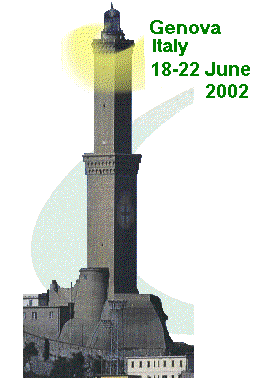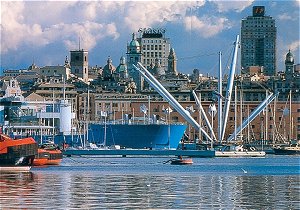

About & Travel to Genova

A commercial port, genteel seaside resort, fine 16th century palaces in a
town proud of its history and legend which was the native place of Christopher
Columbus
Provincial capital of the Liguria region, Genoa is located at the farthest
inmost part of the Gulf of Genoa, along the foothills of the Appennines, with a
coastal extension of about 35 km. It has a population of 676,000 inhabitants,
and is the main commercial port of Italy.
It is an active center for traffic and industry (shipbuilding, steel works,
metal-mechanics industry, deposits and refineries of mineral oils, cement makers,
food, wood and paper industries).
The oldest part of the urban center, a distinctive maze of crowded and narrow
streets leading to the old port, form a striking contrast with the modern part,
spread out on the nearby hills.
The extremely rapid topographical development of the last ten years has
established one continuous spread of habitation from the coast eastward to Nervi
and to the west beyond Sampierdarena, to include the industrial centers of
Cornigliano and Sestri Ponente.
Since 1962 Genoa has had an airport serving the European continent, which was
built on a wide landscaped area obtained by reclaiming a stretch of sea facing
Sestri Ponente.
Artistically speaking, the most lively periods for Genoa were the Middle Ages and the 16th and 17th centuries. The medieval city extended from the port towards the west, the hills and the present monumental bridge, continuing up to Piazza Fontana Marose and "Lanterna" (the symbol of Genoa). The new walls contained the Casteletto and the foothills of the Montegalletto. The neighborhoods were formed by typical small lanes flanked by tall buildings called "caruggi."

These were rich with important monuments: from the churches of San Donato and Santa Maria di Castello to the Cathedral; from Sant'Andrea Gate to the homes of the Doria, and to San Giogio Palace. In the 16th and 17th centuries Genoa's architecture flourished. Famous architects such as G. Alessi, G. B. Castello, G. Ponzello, P.F. Cantone and others created an extremely original complex of churches, towns and above all, princely palaces. Painting and sculpture, essentially decorative in function, developed alongside works of art by painters such as Luca Cambiaso, Valerio Castello, Fiasella, Piola, De Ferrari, Assereto and Carlone. These created an authentic Genoese school with contributions from Flemish painters like Rubens and van Dyck, who lived in Genoa. Following are the principal museums, monuments and points of interest of the city.
By Car
Highway A10 (E80) Ventimiglia-Genoa
Highway A12 (E80) Livorno-Genoa
Highway A7 (E25) Milano-Genoa
Highway A26 Alessandria-Genoa
By Train The trains follow the routes of the major highways.
The Ventimiglia-La Spezia line gathers travelers in western Italy, going to
Turin via Savona-Genoa, Milan via Genoa, Parma via La Spezia and joins the
Tirrenica line for Rome, Naples and the South.
Liguria is served by the principle international lines, coming from Nice,
Moncenisio (near Turin), Gottardo, Germany, Austria and Slovenia.
Rapid connections are guaranteed by the TEE, EC and IC trains, and by
connections with convenient times in all directions
By Plane
The international airport of Genoa Sestri, "Cristoforo Colombo," was
built in the area resulting from a marine landfill. It includes over 130
hectares (some 52 acres) with a landing strip of 2.5 kilometers.
It has an efficient service of land and air assistance. Genoa's airport is
always open and has the unusual characteristic of being centrally located, only
6 km from downtown Genoa.
It has regular service to principal European cities, with major stopovers in
Italy and direct air connections to and from Genoa for: Alghero, Barcelona,
Cagliari, Catania, Frankfurt, Geneva, London (LGW), Milan (LIN), Munich, Naples,
Rome, Trieste, Zurich.
Cristoforo Colombo Airport: 2411
By Ship
The port of Genoa is the most important Mediterranean and transatlantic maritime
headquarters for passengers and merchandise.
Ships arrive from ports in Europe, the Far East, the Americas, Africa and other
continents. Frequent connections are guaranteed on national and Mediterranean
routes, also for car ferries (Sardinia, Sicily, Corsica).
Regular lines travel to the ports of La Spezia, Savona and Imperia. Smaller
tourist ports allow docking of pleasure craft of every size, with optimum
installations and services.
In recent years shipboard vacations are again becoming appreciated. The
introduction of new and up-to-date ships has been an active stimulus to cruise
boats leaving from the port of Genoa.
Maritime Port Services